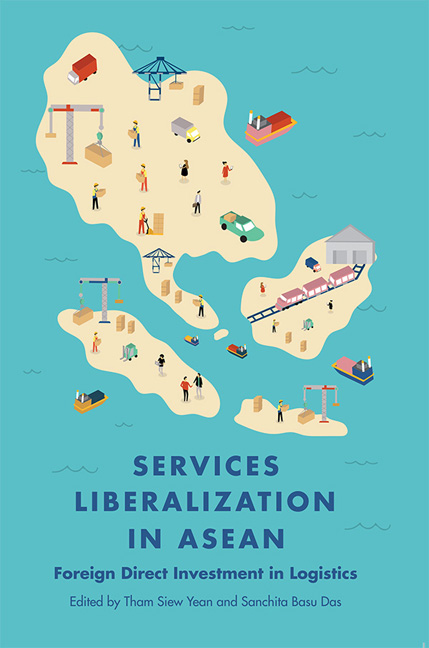Book contents
- Frontmatter
- CONTENTS
- List of Tables
- List of Figures
- Foreword
- Preface
- Acknowledgements
- Abbreviations
- About the Contributors
- 1 Introduction
- 2 Reforming Indonesia's Logistics Sector
- 3 FDI Liberalization in Malaysia's Logistics Services
- 4 Logistics Services Liberalization in the Philippines
- 5 Services Sector Liberalization in Singapore: Case of the Logistics Sector
- 6 Logistics Services Liberalization in Thailand
- 7 Services Liberalization in Vietnam: The Case of FDI in Logistics Sector
- 8 Services Liberalization: Case of Logistics in Brunei
- 9 FDI, Services Liberalization and Logistics Development in Cambodia
- 10 Services Liberalization in Lao PDR: FDI in Logistics Sector of a Land-linked Country
- 11 Facilitating FDI for the Logistics Sector in Myanmar: Agency, Incentives, and Institutions
- Index
2 - Reforming Indonesia's Logistics Sector
Published online by Cambridge University Press: 04 July 2018
- Frontmatter
- CONTENTS
- List of Tables
- List of Figures
- Foreword
- Preface
- Acknowledgements
- Abbreviations
- About the Contributors
- 1 Introduction
- 2 Reforming Indonesia's Logistics Sector
- 3 FDI Liberalization in Malaysia's Logistics Services
- 4 Logistics Services Liberalization in the Philippines
- 5 Services Sector Liberalization in Singapore: Case of the Logistics Sector
- 6 Logistics Services Liberalization in Thailand
- 7 Services Liberalization in Vietnam: The Case of FDI in Logistics Sector
- 8 Services Liberalization: Case of Logistics in Brunei
- 9 FDI, Services Liberalization and Logistics Development in Cambodia
- 10 Services Liberalization in Lao PDR: FDI in Logistics Sector of a Land-linked Country
- 11 Facilitating FDI for the Logistics Sector in Myanmar: Agency, Incentives, and Institutions
- Index
Summary
Introduction
Indonesia's services sector is relatively small at 42 per cent of Gross Domestic Product (GDP), compared to an ASEAN average of 47.3 per cent and a world average of 68.3 per cent in 2014. The share of services to GDP increased marginally from 40.6 per cent in 2011 to 42 per cent in 2014. Services trade as a share of total trade is also relatively low at about 6.4 per cent in 2014 compared to the world average of 13 per cent. Furthermore, compared to the manufacturing sector, policies governing the services sector are relatively more restrictive, as for example in the case of Indonesia's foreign direct investment (FDI) policy.
The logistics sector is no exception to the above pattern in Indonesia's services performance. The contribution and performance of this sector is below that of Singapore, Malaysia and Thailand. The World Bank's Logistics Performance Index (LPI) indicated that Indonesia's logistics performance ranked the 63rd out of 160 countries, while Singapore ranked the 5th, Malaysia the 32nd and Thailand the 45th (World Bank 2016).
Given its current performance, improving the logistics sector's efficiency is among the main priorities of the current government. The immediate challenge for Indonesia is to make the sector more efficient so that logistics cost can be reduced, remove barriers to entry as well as to improve the quality of logistics infrastructure. The logistics cost for international and domestic freight in Indonesia in relatively high compared to its peers in the region. World Bank (2012) reported the typical charge for a forty-foot dry container or a semi-trailer (total freight including agent fees and other charges) in 2012 was only US$178 in Singapore while it costs around US$415 in Indonesia. Therefore, the logistics costs for exporting and importing in Indonesia are more expensive than a neighbouring high labour cost country like Singapore.
Domestic logistics cost in Indonesia, especially inter-island, is also higher than international export–import costs. The cost of sending a 100-kilogram package from Jakarta to Tanjung Pinang, in Kepulauan Riau Province of Indonesia, using Jalur Nugraha Ekakurir's (JNE) cheapest service is IDR2.5 million (about US$260).
- Type
- Chapter
- Information
- Services Liberalization in ASEANForeign Direct Investment in Logistics, pp. 42 - 76Publisher: ISEAS–Yusof Ishak InstitutePrint publication year: 2017

